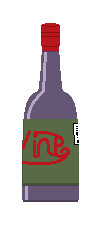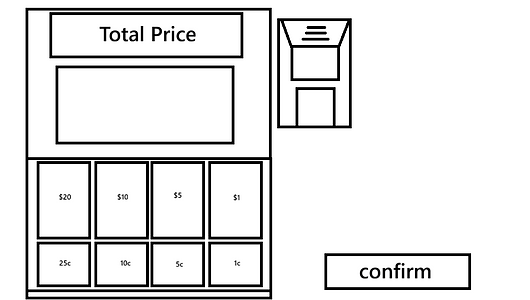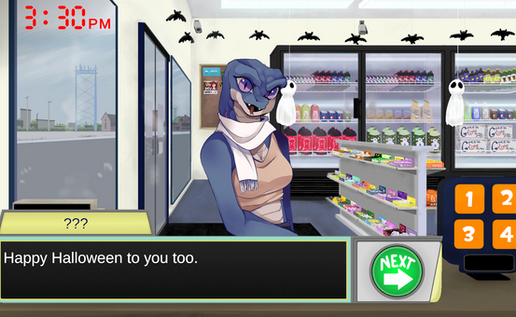
My Development
Due to the extended time of the jam and no certain themes other than a Halloween-themed Visual Novel, this was a great opportunity to execute a concept I had to expand the worldbuilding for See Only Evil.
What if a mutant works at a regular nine-to-five job and tries to have a regular life?
So I took it upon myself to become the Lead Narrative & Game Designer and Unity Programmer for the project. Before the start of the Jam, I did team searching. I posted a thread on both the Devtalk Discord server and the Jam's forums that I am creating a team and made an open audition to find voices for the characters in Casting Call Club. I managed fill nearly every role except for a UI Artist, so I gave that role to myself.
Planning and Writing
Before I started creating the game, I first had to plan for what the game will have, what mini-games I need to include and how will the story would unfold.
I created a 'Player' Path Graph' to figure out how the game story will play out and the different paths the player can make on the choices they make.
(Context: the link above is an early draft of the graph, it includes choices and other elements that were scrapped due to pacing and/or narrative flow.
The purpose is to lay out the paths the player could make during gameplay. I also include 'Checkpoints' to seperate each encounter to put everything back into a linear sequence. )
(Context: The following sample is the 5th draft of the Regular Customer's encounter. The document includes comments from the proofreader and my responses to those comments.
Note: To make it easier to copy/paste the script into the project, I had to remove the original lines that were changed.)
Once I figured out the path, the next step was the dialogue. With the total of 10 scenes. I created a Word document for each scene, keeping track of choices, making sure the conversation remains consistent to its path.
After fully writing the dialogue, next step was editing, I ended up making 5 drafts and got one of the artist to proofread the work. after getting feedback, I made comments and changes, either agreeing with the proofreader and making the changes or counter the change by giving the reason and why it works as it is.
This process took a total of 15 days, nearly half of the time we had.
Finishing the editing and proofreading, I proceeded to write voice scripts for the voice actors. A point of no return for editing.
I originally used Microsoft Word to write the dialogue, but used Trelby for a professional format. I took each character, looked at all the documents and wrote down each line that the character will say in the game. There were a total of 9 characters, and it took me roughly 1-2 days to complete all the characters before sending the scripts to the voice actors.
(Context: The following document is a PDF voice script for the character Igor Meme. Since Igor is the protagonist, there are over 300 lines in this document, filling up 24 pages of dialogue lines.)
Mini-Games
Along with planning the dialogue, I also wanted the visual novel to have more interactions, so I thought of mini-games, quickly thinking about how people working at a counter would work. Ended up with 3 Mini games based on scanning and paying.
1. Gas Recipt
The first one needed to be incredibly simple and not too complex. so I thought of a way for the customer to pay for the gas. by giving you a recipt and you have to press a button on the 'Gas machine' to scan for the price, it might be unrealistic but it's for the sake of interactvity of the game.
The game is simple; the receipt number randomly generates a number from 1-4, and the player has to press the right button to be successful.
Unlike the other mini-games, the Gas receipt mini-game is played on a canvas and not in the world space. This is due to the use of buttons.

(Early Layout design of the Gas recipt Mini Game.)
2. Product Scanning
The next Mini-game, I wanted so that you can still see the customer while doing the game, having interactable products appear on the side, and it's up to you to scan the products on the scanner. learned to use 'click and drag' with this game, and added a few more features, such as the cost of the products when scanned, highlighting the products and rotating the products.
However, there were more that I could have done, such as using gravity, having the desk floor collide with the product, but it was a lot harder to program, so I ended up doing a 'let go and it reverts back to where it was' deal for the sake of keeping it easy and not too complicated.








(All the Scannable interactable products, I made the asset art)
3. Cash Payment

Out of the 3 Mini games, Cash Payment is the most complicated, as it requires the use of maths and a lot of triggers and Game Objects to make this work.
Cash Payment connects with the previous 2 mini-games, as it adds whatever number selected in Gas Receipt, all the products scanned in Product Scanning and an 8% Sale tax added from the total price to make up for the final price (since the game takes place in the US.)
(Early Layout Design for Cash Payment)
Cash Payment is the only mini-game that has phases.
Phase 1 - Payment:
Putting the cash in the box, and making sure the cash is in the right box. putting a coin in the wrong box will cause payment error.
Phase 2 - Change:
Taking the cash out and putting it out, but making sure the change is the right amount, going over would cause a payment error.
there are also other features, such as the customer not wanting change, thus skipping phase 2, and a completley different payment, using card scanning.



(Cash Assets.)
(Fun fact: In Phase 2, when taking the cash out, it uses the same game object of the coin/note, when let go, the object turns off, waiting to be recalled again.)
Data Collecting & Endings
Igor Meme has a total of 3 endings. a Good Ending,
a Middle Ending and a Bad Ending.
How the player get either one of the endings is through a point collecting system in a game object that never gets destroyed.
This system checks the actions of the player. If the player does something that would count as a point, such as making a payment error or making a negative choice. it would add points or check boxes.
I also created a script at the end of the game that collects points and put out an ending, not before going through each mistake with dialogue.
0 = Good ending, 1-4 = Middle Ending 5+ = Bad Ending

(Image of the Main Data script used for the point collecting system, the system uses Ints and Bools to collect data. Other scripts were made on certain dialogue boxes search for the main data and either set true on a bool or add 1 point to either of the Ints.)
Conclusion
Overall, after creating the game, I felt pleased with the result, happy that I managed to get the game done
while slightly overscoping.
What did not get in are:
1) - Passtime:
intermission between encounters to explore the store,
interact with objects and play mini games.
2) - images for endings:
CGs of Igor in each ending
3) - Bonus Easter egg:
a Non-canon secret encounter where Minda from Rebecca Origin's. Her appearance would
have been after the Minda Webcomic.
These never happend due to the deadline coming close, but I believe cutting out Passtime made the game better, as including it would have made it boring due to a lack of interactions and more player involvement
in pointless mini-games
I would've also improved more of the Stress system that I added. While it did its job of having negative choices appear when stress is high, I thought of other ideas, such as a game over at 100% and stress affecting mini games, but again, I had to consider time and do what I can for the system. but still happy with what came out.

Igor Meme
Imagine this, an ugly, hideous, terrifying, evil-looking monster that will give anyone nightmares… working at an American gas station.
That is the life of Igor Meme, a regular guy with a deformed mutation, struggling through his work life until he has a chance to work at the counter on Halloween Night, can Igor take up such a responsibility or struggle through the stressful work of dealing with annoying customers and those who judge his appearance?
Igor Meme is a 2D, story-focused, Visual Novel that features choice branching, 3 mini-games that simulate working at a gas station, Data collecting that determines an ending and a stress system which affects the choices available for the player.
The game was created for the 7th Annual Spooktober Visual Novel Jam. The game took 30 days to develop and was created by a team that included 2 Artists, 1 music and sound designer, and 9 Voice Actors.
.png)





